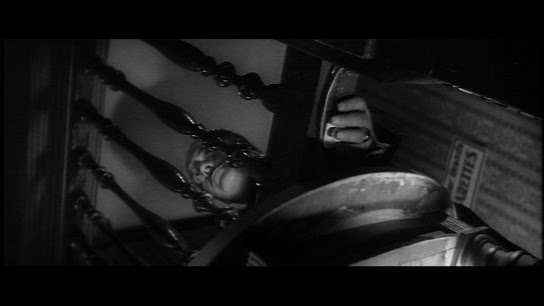The Phantom of Soho (Der
Phantom von Soho) (1964) is an above-average Krimi film. (Krimi refers
to a genre of German mystery films made primarily in the 1960s, set in London,
and based upon the novels of Edgar Wallace and, to a lesser extent, his son,
Bryan Edgar Wallace.) While I have not yet
seen a great Krimi film, I have seen
some very good ones; and The Phantom of
Soho is one of those few: admirable
detail is given to the sets and costumes, giving an appearance of a very
credible-looking 60s London; the English dubbing and the jazzy score by Martin
Bӧttcher are well composed; and finally, there is a panache to the direction by
Franz Josef Gottlieb, especially (and unsurprisingly) in the phantom’s kill
scenes. However, and again like most krimi films, Phantom suffers from poor characterization sacrificed towards its
formulaic plot. Its story never allows
for a particularly good performance; and when Phantom is not enticing the eyes, its talky bits become repetitive
and dull.
The Phantom of Soho, based upon the story by Bryan Edgar Wallace,
concerns the titular area in London, where a group of important men, like
members of Parliament, are being killed by a knife-wielding phantom in its
dark, shadowy alleys. A cabaret located
in the area is seemingly focal to the killings where many of the important
gentlemen are seen shortly before their murders. Not only are all of the murders linked to the
doings at the cabaret, but the victims themselves are linked to an event in the
past. Chief Inspector Hugh Patton (Dieter
Borsche) and Sergeant Hallam (Peter Vogel) are on the case.
Most of the characters in Phantom are pawns in service of the
story: nearly all are interchangeable
and have no weight until the drama determines his/her function: red herring;
genuine suspect; or investigator. Two of
the best characters are a mystery writer named Clarinda Smith (Barbara Rütting)
and a pretty photographer at the cabaret named Corinne Smith (Helga
Sommerfeld). Phantom begins with Clarinda fireside with the head of Scotland
Yard, Sir Phillip (Hans Sӧhnker), and their cozy fireside chat is interrupted
by a phone call, detailing to Sir Phillip the finding of the first murder
victim. Over the course of Phantom, Clarinda appears auspiciously
at key locations uncovering clues or in possession of insider information. It is difficult to tell throughout the film
whether Clarinda is playing Sir Phillip for a fool by extracting information
from him to inform her new mystery novel or whether she is a genuine suspect or
a budding amateur sleuth. The screenplay
of Phantom by Ladislas Fodor does not
really flesh out her aspects of the story.
Helga Sommerfeld who plays the pretty photographer Corinne is as
charismatic and captivating as krimi
favorite, Karin Dor; yet she does not move beyond eye candy. Sommerfeld appears
adept at comedy and drama in her few scenes. Unfortunately, Corinne appears
early on and disappears just as quickly, not so much a character but a plot
device.
The allure of Phantom is in its visuals and its
atmosphere. The smoky, dark alleys; the
gliding, always moving camerawork (by Richard Angst); and the first-person
camera kill scenes show this krimi is
a definite distant cousin of the giallo
and undeniable inheritor of noir
cinema. The cabaret sequences with their
dance sequences are wonderfully risqué without being lewd. There is an especially interesting and daring
action sequence late in the film at a train yard. Typically when I watch a krimi film, at some point I will zone out for a few minutes and
miss a plot detail (which I have learned is not so much a big deal as plot
holes are quite common in the cinema).
In Phantom, the plot is so
mechanical it plays out with little need of focused attention. When a little twist appears towards the
motive of the killer, it results in either revenge or money. I could have cared less. I wished there would have been less talking
and exposition and more focus on the characters and the visuals. By no means is The Phantom of Soho a waste of time: it can easily serve as representative of the
genre; a standout; or a fine introduction to the krimi.





No comments:
Post a Comment